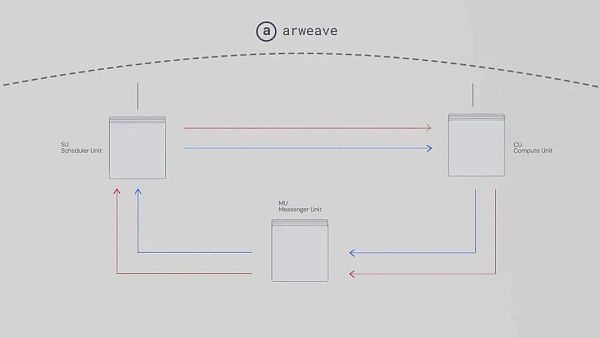Author: Pan Zhixiong
AO is actually an open and flexible data protocol for storing computational logs on top of Arweave's protocol. It is not a permanent ledger, nor is it a network per se.
After preheating for many days, the Arweave team finally announced the launch of a parallel computer solution called AO at the press conference. They went from conception to development It has been around for a year, but its earliest history can be traced back to SmartWeave, a smart contract solution based on permanent storage proposed by Arweave four years ago. The choice of these technical solutions is very different from Ethereum or other Ethereum-like networks: Ethereum started with a Turing-complete virtual machine and gradually expanded its territory; while Arweave started with a network that provided permanent storage, and then gradually added computing ability.
Full text of press conference transcript [Chinese and English]:https://bodhi.wtf/13921
There are too many technical topics worthy of comparison and in-depth exploration, and it is unlikely that the Arweave team can fully explain all the technical highlights and ideas in more than an hour. After watching the press conference, I compiled these issues and topics worth paying attention to.
What is AO?
AO is a hyperparallel computer, which is a decentralized computing environment that allows any number of processes to run in parallel at the same time. Compared with previous decentralized computing systems, AO can achieve both large-scale computing and verifiable computing. The core of AO is that it not only increases the number of verifiable calculations, but also realizes verifiable calculations of any magnitude. By building three different sub-networks and using Arweave as the basic layer, it achieves a high degree of parallel processing capabilities and verifiable calculations. Scalability.
Why the name AO?
Taken from the concept of "Actor Oriented", the abbreviation is AO.
There is a concurrent computing model in computer science called Actor Model, which is used to design and implement distributed systems, in which the basic unit is "Actor". Actor Oriented design or programming refers to a design or programming method based on the Actor model. This method is suitable for building highly concurrent, distributed, and fault-tolerant systems.
Arweave founder Sam Williams believes that AO is a completely different programming paradigm from smart contract systems, and this is basically all distributed systems and Web2 in the world. The best solution of the era.
An example given to me by GPT4: It can be compared to an actor in a drama performance. In a drama, each actor plays a role, and they act independently, interacting with other actors through dialogue (messages), but they do not share each other's internal state (private state), each actor can only observe other actors' actions (received messages) to react.
Additional interesting fact: The title of the paper that proposed the Actor Model in 1973 was "A Universal Modular Actor Formalism for Artificial Intelligence". To study artificial intelligence.
Paper link:
https://dl. acm.org/doi/abs/10.5555/1624775.1624804
What parts does AO consist of?
AO consists of three subnets, namely Messenger Unit and Scheduling Unit ( Scheduler Unit) and Compute Unit (Compute Unit), the abbreviations are MU, SU, and CU respectively. MU is responsible for receiving and processing information; SU is used for scheduling and sorting information; CU is used for processing calculations.

What is the relationship between AO and Arweave?
"AO is actually an open and flexible data protocol for storing calculation logs on Arweave's protocol. It is not a permanent The ledger is not a network itself."
As a decentralized computing environment, AO uses Arweave's scalable on-chain storage as its permanent host for storage data during operation. AO can allow any number of parallel processes to run simultaneously and coordinate with each other through message passing, similar to how computers in data centers and the Internet work together by sending packets of data.
In short, AO is built on the basic layer of Arweave and uses the on-chain storage function provided by Arweave to achieve the persistence of its decentralized computing environment. storage requirements.
What is the relationship between AOS and AO?
What kind of programming language is Lua?
AO is a parallel computer architecture, and AOS is a specific operating system based on this parallel computer solution. Developers can use Lua language to develop applications (write smart contracts) in AOS.
Lua is an easy-to-use high-level language that is very concise and easy to use. Coincidentally, I wrote some scripts in Lua almost 4 years ago, and it is indeed an easy programming language to get started with. At that time, I had zero knowledge of Lua, but I needed to use the automation tool HammerSpoon to implement some functions for obtaining prices and information. I completed it within a few days. It's even easier if GPT helps.
What are the applications of AO?
Currently, the community has been organized to develop two applications, namely the decentralized exchange Bark and the decentralized stablecoin protocol astro. Bark has been launched on the test network, and astro will be made public later.
everVision founder Outprog also appeared at the press conference, and was frequently mentioned by Sam. The decentralized trading platform Permaswap they developed was long before the AO project was established. There will also be opportunities to further develop and expand under the AO framework.
Will AO be iteratively updated soon?
Sam said that he expects that only Bitcoin-style updates will be needed in the future (i.e. very infrequently). Over time, users' core functionality and rights will remain unchanged with minor upgrades. There’s no “trust me, brother” road map here. There is only one complete and transparent protocol that you can audit and decide whether to use for yourself.
 JinseFinance
JinseFinance
 JinseFinance
JinseFinance JinseFinance
JinseFinance JinseFinance
JinseFinance JinseFinance
JinseFinance JinseFinance
JinseFinance JinseFinance
JinseFinance JinseFinance
JinseFinance JinseFinance
JinseFinance JinseFinance
JinseFinance Samantha
Samantha